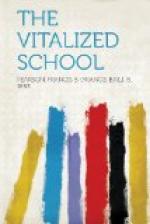=Analysis and synthesis.=—The question-and-answer method evermore implies analysis. But children are inclined to synthesis, which shows at once that the analytic method runs counter to their natural bent. They like to make things, to put things together, to experiment along the lines of synthesis. Hence the industrial arts appeal to them. But constructing problems satisfies their inclination to synthesis quite as well as constructing coat-hangers or culinary compounds, if only the incitement is rational. The writers of our text-books are coming to recognize this fact, and it does them credit. In time, we may hope to have books that will take into account the child’s natural inclinations, and the schools will be the beneficiaries.
=Thinking.=—In the process of synthesis the pupil is free to draw upon the entire stock of his accumulated resources, whereas in the question-and-answer method he is circumscribed. In the question-and-answer plan he is encouraged to remember; in the other he is encouraged to think. In our theories we exalt thinking to the highest pinnacle, but in our practice we repress thinking and exalt memory. We admonish our pupils to think, sometimes with a degree of emphasis that weakens our admonition, and then bestow our laurel wreaths upon those who think little but remember much. Our inconsistency in this respect would be amusing if the child’s interests could be ignored. But seeing that the child pays the penalty, our inconsistency is inexcusable.
=Penalizing.=—The question-and-answer regime, in its full application, is not wholly unlike a punitive expedition, in that the teacher asks the question and sits with pencil poised in air ready to blacklist the unfortunate pupil whose memory fails him for the moment. The child is embarrassed, if not panic-stricken, and the teacher seems more like an avenging nemesis than a friend and helper. Just when he needs help he receives epithets and a condemning zero. He sinks into himself, disgusted and outraged, and becomes wholly indifferent to the subsequent phases of the lesson. He feels that he has been trapped and betrayed, and days are required for his redemption from discouragement.
=Traditional method.=—In the school where this method is in vogue the examination takes on the color and character of the recitation. At the close of the term, or semester, the teacher makes out the proverbial ten questions which very often reflect her own bias, or predilections, and in these ten questions are the issues of life and death. A hundred questions might be asked upon the subjects upon which the pupils are to be tested, but these ten are the only ones offered—with no options. Then the grading of the papers ensues, and, in this ordeal, the teacher thinks herself another Atlas carrying the world upon her shoulders. The boy who receives sixty-seven and the one who receives twenty-seven are both banished into outer darkness without recourse. The teacher may know that the former boy is able to do the work of the next grade, but the marks she has made on the paper are sacred things, and he has fallen below the requisite seventy. Hence, he is banished to the limbo of the lost, for she is the supreme arbiter of his fate.




